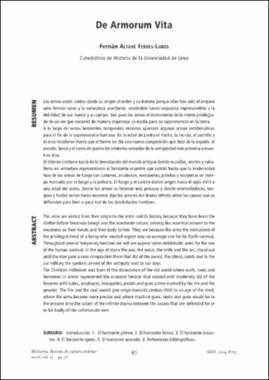| dc.contributor.author | Altuve Febres Lores, Fernán | |
| dc.contributor.other | Altuve Febres Lores, Fernán | |
| dc.date.accessioned | 2018-05-03T18:39:45Z | |
| dc.date.issued | 2003 | |
| dc.identifier.citation | Altuve-Febres Lores, F. (2003). De Armorum Vita. Militaria: Revista de Cultura Militar, (17), 45-73. Recuperado de https://revistas.ucm.es/index.php/MILT/article/view/MILT0303110045A | es |
| dc.identifier.issn | 0214-8765 | |
| dc.identifier.uri | https://hdl.handle.net/20.500.12724/5984 | |
| dc.description.abstract | Las armas están unidas desde su origen al orden y su historia porque ellas han sido el amparo ante feroces seres y la naturaleza acechante, sirviéndole como respuesta imprescindible a la debilidad de sus manos y su cuerpo. Son pues las armas el instrumento de la mente privilegiada de un ser que necesitó de manera imperiosa un medio para su supervivencia en la tierra. A lo largo de varios horizontes temporales veremos aparecer algunas armas emblemáticas para el fin de la supervivencia humana. En la edad de piedra el hacha, la honda, el cuchillo y el arco resaltaron hasta que el hierro les dio una nueva composición que hizo de la espada, el escudo, lanza y el carro de guerra los símbolos armados de la antigüedad más próxima a nuestros días. El milenio cristiano nació de la devastación del mundo antiguo donde murallas, arietes y caballeros en armadura representaron el horizonte ecuestre que existió hasta que la modernidad hizo de las armas de fuego con cañones, arcabuces, mosquetes, pistolas y escopetas un tiempo marcado por el fuego y la pólvora. El fuego y el carbón darían origen hacia el siglo XVIII a una edad del acero, donde las armas se hicieron más precisas y donde ametralladoras, tanques y fusiles serían hasta nuestros días los actores del drama infinito entre las causas que se defienden para bien o para mal de los desdichados hombres. | es_PE |
| dc.description.abstract | The arms are united from their origin to the order and its history because they have been the
shelter before ferocious beings and the acechante nature, serving like essential answer to the
weakness as their hands and their body to him. They are because the arms the instrument of
the privileged mind of a being who needed urgent way an average one for his Earth survival.
Throughout several temporary horizons we will see appear some emblematic arms for the aim
of the human survival. In the age of stone the axe, the wave, the knife and the arc, stood out
until the iron gave a new composition them that did of the sword, the shield, sends and to the
car military the symbols armed of the antiquity next to our days.
The Christian millenium was born of the devastation of the old world where walls, rams and
horsemen in armor represented the ecuestre horizon that existed until modernity did of the
firearms with tubes, arcabuces, mosquetes, pistols and guns a time marked by the fire and the
powder. The fire and the coal would give origin towards century XVIII to an age of the steel,
where the arms became more precise and where machine guns, tanks and guns would be to
the present time the actors of the infinite drama between the causes that are defended for or
or for badly of the unfortunate men. | en_EN |
| dc.format | application/pdf | |
| dc.language.iso | spa | |
| dc.publisher | Universidad Complutense de Madrid | |
| dc.relation.uri | https://revistas.ucm.es/index.php/MILT/article/view/MILT0303110045A | |
| dc.rights | info:eu-repo/semantics/openAccess | * |
| dc.rights.uri | https://creativecommons.org/licenses/by-nc-sa/4.0/ | * |
| dc.source | Repositorio Institucional - Ulima | |
| dc.source | Universidad de Lima | |
| dc.subject | Armas | es |
| dc.subject | Historia | es |
| dc.subject | Weapons | en |
| dc.subject | History | en |
| dc.title | De Armorum Vita | es_PE |
| dc.type | info:eu-repo/semantics/article | |
| dc.description.peer-review | Revisión por pares | es |
| dc.identifier.journal | Militaria: Revista de Cultura Militar | |
| dc.identifier.eissn | 1988-3315 | |
| dc.publisher.country | ES | |
| dc.type.other | Artículo | |


